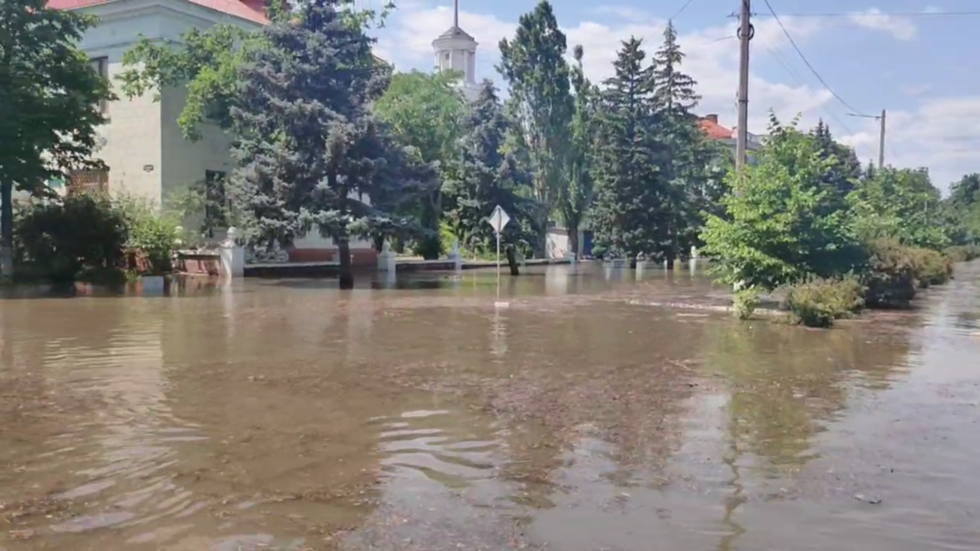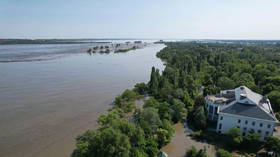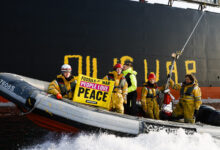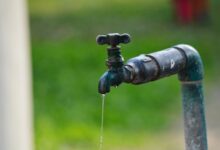
The incident could damage local agriculture businesses and pose a risk to Europe’s biggest nuclear power plant, authorities have said © RT
The destruction of the hydroelectric dam near the city of Novaya Kakhovka in Russia’s Kherson Region poses a risk to local agriculture and may affect operations at the Zaporozhye Nuclear Power Plant (ZNPP), Evgeny Balitsky, the acting governor of nearby Zaporozhye Region, told journalists on Tuesday.
The water level in a reservoir near the ZNPP has fallen by 2.5 meters, Balitsky said, adding that a further reduction in water levels is possible. “We expect the drop to be even bigger, up to seven meters,” he told the TV channel Russia 24. The water is critical for cooling the reactors and spent fuel at the facility, thus preventing meltdowns. The ZNPP is the largest nuclear power plant in Europe.
Balitsky denied that such a development could “affect security in the area or in our regions on the whole in any way.” He also said that the current water level near the ZNPP is “non-routine” but still “acceptable.” The head of the International Atomic Agency (IAEA), Rafael Grossi, also said on Tuesday that “there is no immediate risk to the safety of the plant.”
He added that the water level in the reservoir was “at around 16.4 meters” on Tuesday morning but was still falling. “If [it] drops below 12.7 m then [water] can no longer be pumped to cool the station,” Grossi warned, adding that “absence of cooling water … for an extended period of time would cause fuel melt and inoperability of the emergency diesel generators.”

Read more
Balitsky warned on Tuesday that the destruction of the dam would also likely “damage” the region’s agriculture industry due to a lack of water in the local irrigation channels. “The water in the channels would be enough for a month and a half,” he said, adding that local agriculture businesses are likely to survive this season but would need the problem to be resolved by next year.
The governor of Kherson Region, Vladimir Saldo, issued a similar warning on Tuesday. “As soon as the water level falls – and it will happen rather soon – the reservoir will lose the water reserves destined for irrigation,” he said.
The authorities in Crimea, which also receives water from the Dnieper River, where the Kakhovka dam was located, said they have “more than enough” water reserves to deal with a potential shortage. Nevertheless, Crimea’s governor, Sergey Aksyonov, still admitted that the loss of the dam could lead to the water level falling in the North Crimean channel, which links the peninsula to the Dnieper River.
Vladimir Leontyev, the mayor of Novaya Kakhovka, which is located downstream from the destroyed dam, said that water levels within the city continued to rise throughout the day. “The water [level] soared by more than 11 meters,” he said, adding that this is more what had been initially expected after the dam ruptured.
Leontyev also warned that the hydroelectric dam continues to crumble and that its turbine room has flooded. Videos taken in Novaya Kakhovka and obtained by RT show the city streets inundated with streams of muddy water.
The dam was destroyed by an explosion early on Tuesday. Russian Defense Minister Sergey Shoigu called the incident an act of “sabotage” by Ukrainian forces and also referred to it as a “terrorist act.” The fact that the Ukrainian authorities had started dropping the water level at another dam on the Dnieper River that they control suggests it was a “large-scale sabotage attack planned by the Kiev regime in advance,” he said. Ukraine denied responsibility and blamed the incident on Moscow instead.




